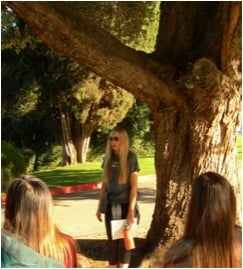University of Redlands Emergency Alert System
Alert Received: . For more information, visit: https://www.redlands.edu/alert/
University of Redlands
- Home
- Trees
- Species Accounts
- Canyon Live Oak
Common Name: Canyon Live Oak
Scientific Name: Quercus chrysolepis
Family: Fagaceae
Identification
Habit: An evergreen tree that grows 20-65 ft (6-20 m) tall with a trunk that ranges from 12-39 in (30-100 cm) in diameter. The oak is about as wide as it is tall. It grows in dry, open habitats, usually at higher elevations. When young, the tree grows and divides into large horizontal branches with a wide-spreading crown.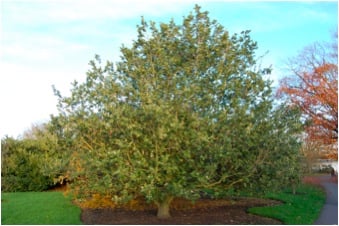
Leaves: Oblong to elliptic (long oval to egg-shaped); 3/4 to 3 in (2-8 cm) long. They are flat and firm with smooth to toothed margins. The leaves are dark green and shiny on top, but the lower surface is pale with a layer of yellowish “felt” (fine hairs).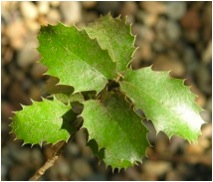
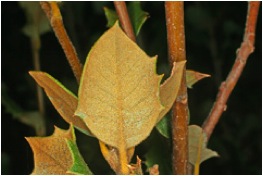
Twigs and Bark: The mature trunk bark is thick, gray, and scaly, with touches of red scattered along the trunk. Further up the tree, the bark becomes smoother and a more grayish color. The twigs are long, thin, smoother than the trunk bark, and a lighter gray to brown color.
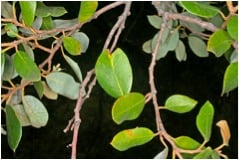
Flowers and Fruits: Acorns are the one-seeded nuts used for reproduction. The cup is composed of thick skin and brown scales and the nut itself is oval and wide, ripening from green to brown. The acorns are big: 3/4 to 2 1/4 in (2-6 cm) long, 1/2 to 1 1/4 in (1-3 cm) wide, and mature in less than 2 years. On average, the oak has high acorn production once every 2-3 years. The flowers are yellow and bloom in the spring. Male flower clusters are vine-like with no petals, but with clusters of stamens (pollen-producing parts) coming off the vine-like structures.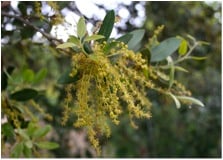

Where it’s from
Native range: Canyon live oak can be found in the southwestern United States down to northwestern Mexico. Its full range includes Oregon down the west coast and a little in Arizona. They are mostly found in mountainous areas on moderate to steep slopes. Their habitat is characteristically dry. The oaks can be found at an elevation of 650-9000 ft (200-2700 m) on rocky slopes and are prevalent in conifer and evergreen forests of California. The densest populations of canyon live oak are found in northern California.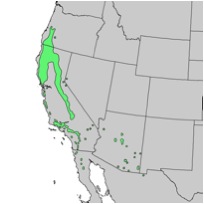
Ecological notes: This oak is wind-pollinated, like all other oaks. In its native habitat, it forms thickets on dry slopes. The oak can be found from acidic to neutral, moist to dry soil. It is drought tolerant and grows in full sun exposure to partial shade. The soil the oak is found in may have a clay, loam, or sand texture. The Canyon Live Oak has many ecological benefits including attracting wildlife, such as birds and squirrels, to open areas due to its ability to easily house and feed them. The wide range of the oak’s living conditions put it on the USDA high hardiness list.
What we use it for
It is a desired tree for many California residents since it thrives in infertile soils and is drought resistant. It is useful for restoring wildlife to areas where forests have been burned or in open hilly areas where good protection is scarce. It is good for butterfly and bird gardens too since its canopy is very desirable for those creatures. Many people plant the oak to prevent mudslides and soil erosion since its roots hold the rocky hillsides. We also use the wood, bark, and acorns of the canyon live oak tree. The wood is durable and good for uses such as flooring and cabinetry. It is also very good for producing wine barrels which means that the wine industry in California can use these native trees as a source of wood. The bark has a few uses, an interesting one being for medicine. People brew oak bark in a tea to treat colds, fevers, bronchitis, and to stimulate the appetite. The acorns can be used to produce oil and flour, but since they have chemicals in them called tannins, they have to be processed first. Many farmers release their pigs in oak-dense areas to eat these fat-rich acorns to fatten up for better meat.
References
Image URLs
Biographer
Ramanis, Marlena ’21, FYS 20: Plants in Our World, Fall 2017